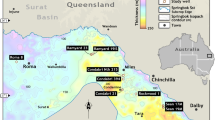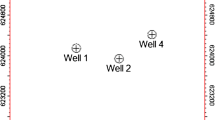Abstract
In the framework of a \({{\hbox {CO}}}_{2}\) storage feasibility study, we evaluate porosity and permeability of shale formations constituting the overburden of a hydrocarbon reservoir, where the gas is stored. These properties are required to perform fluid-flow simulations and analyze possible leakages from the reservoir to the surface. In this process, calibration with well logs is essential. Standard log-interpretation procedures on shales may induce errors, since the shale part is discarded due to its apparent negligible permeability compared to the clastic part. In this study, it is the “shale effect” that we consider by introducing its contribution to porosity and therefore to permeability, so that new expressions are developed to obtain porosity from density and traveltimes that consider this effect. Indeed, shales have non-zero porosity and finite permeability even if the flow rates are several orders of magnitude smaller than those in sandstones. Moreover, calibration does not mean to honour one single log profile but the interpretation should be compatible with all the profiles available. We obtain clay content, porosity and permeability from two wells offshore Malaysia using the linear and Stieber relations between gamma ray and shale volume. The results of using these relations are quite similar. However, the analysis shows that the density logs yield too small values of porosity. Instead, the sonic log gives a better estimate of porosity that honours the P-wave velocity. The verification is performed by using the Krief–Gassmann equations to obtain the P-wave velocity, either from the density-log or from sonic-log derived porosities. This is also confirmed by comparison to porosity obtained from the neutron log.




















Similar content being viewed by others
References
Backeberg NR, Iacoviello F, Rittner M, Mitchell TM, Jones AP, Day R, Wheeler J, Shearing PR, Vermeesch P, Striolo A (2017) Quantifying the anisotropy and tortuosity of permeable pathways in clay-rich mudstones using models based on X-ray tomography. Sci Rep 7:14838. https://doi.org/10.1038/s41598-017-14810-1
Brown K, Whittaker S, Wilson M, Srisang W, Smithson H, Tontiwachwuthikul P (2017) The history and development of the IEA GHG Weyburn-Midale CO2 monitoring and storage project in Saskatchewan, Canada (the world largest CO2 for EOR and CCS program). Petroleum 3:3–9
Busch A, Bertier P, Gensterblum Y, Rother G, Spiers CJ, Zhang M, Wentinck HJM (2016) On sorption and swelling of CO\(_2\) in clays. Geomech Geophys Geo-energ Geo-resour 2(2):111–130
Carcione JM (2014) Wave fields in real media. Theory and numerical simulation of wave propagation in anisotropic, anelastic, porous and electromagnetic media, Elsevier (Third edition, extended and revised)
Carcione JM, Gurevich B, Cavallini F (2000) A generalized Biot–Gassmann model for the acoustic properties of shaley sandstones. Geophys Prosp 48:539–557
Carcione JM, Picotti S, Gei D, Rossi G (2006) Physics and seismic modeling for monitoring CO2 storage. Pure Appl. Geophys. 163:175–207
Carcione JM, Gei D, Yu T, Ba J (2018) Effect of clay and mineralogy on permeability. Geophys Pure Appl. https://doi.org/10.1007/s00024-019-02117-3
Carman PC (1961) L’ écoulement des gaz á travers les milieux poreux, Bibliothéque des Sciences et Techniques Nucléaires, Presses Universitaires de France, Paris
Clavier C, Hoyle W, Meunier D (1971) Quantitative interpretation of thermal neutron decay time logs: Part I. Fundamentals and techniques. J Pet Technol 23:743–755
Crain ER (2018) Crain’s petrophysical handbook. www.spec2000.net
Ellis DV, Singer JM (2008) Well logging for earth scientists. Springer, Berlin
Fang Y, Wang C, Elsworth D, Ishibashi T (2017) Seismicity-permeability coupling in the behavior of gas shales, CO\(_2\) storage and deep geothermal energy. Geomech Geophys Geo-energ Geo-resour. https://doi.org/10.1007/s40948-017-0051-9
Janjuhah HT, Salim AMA, Ghosh DG (2017) Sedimentology and reservoir geometry of the Miocene carbonate deposits in Central Luconia, Offshore, Sarawak, Malaysia. J Appl Sci 17(4):153–170
Kozeny J (1927) Über kapillare leitung desWassers im Boden: Sitzungsberichte derWienerAkademie desWissenschaften 136:271–306
Kuila U, Prasad M (2013) Specific surface area and pore-size distribution in clays and shales. Geophys Prosp 61:341–362
Larionov VV (1969) Radiometry of boreholes (in Russian). NEDRA, Moscow
Masoudi R, Jalil MAA, Press D, Lee K-H, Phuat C, Anis L, Darman N, Othman M (2011) An integrated reservoir simulation-geomechanical study of feasibility of CO2 storage in M4 carbonate reservoir, Malaysia, International Petroleum Technology ConferenceIPTC 15029
Ngo VT, Lu VD, Le VM (2018) A comparison of permeability prediction methods using core analysis data for sandstone and carbonate reservoirs. Geomech Geophys Geo-energ Geo-resour 4(2):129–139
Picotti S, Carcione JM, Gei D, Rossi G, Santos JE (2012) Seismic modeling to monitor CO2 geological storage—the Atzbach-Schwanenstadt gas field. J Geophysics Res Solid Earth 117(6):B06103. https://doi.org/10.1029/2011JB008540
Picotti S, Carcione JM, Ba J (2018) Rock-physics templates for seismic \(Q\). Geophysics 84(1):MR13–MR23
Savioli GB, Santos JE, Carcione JM, Gei D (2016) A model for CO2 storage and seismic monitoring combining multiphase fluid flow and wave propagation simulators. The Sleipner-field case. Comput Geosci. https://doi.org/10.1007/s10596-016-9607-y
Singh KK, Singh DN, Ranjith PG (2015) Laboratory simulation of flow through single fractured granite. Rock Mech Rock Eng 48:987–1000
Stieber SJ (1970) Pulsed neutron capture log evaluation—Louisiana Gulf Coast: Society of Petroleum Engineers Annual Fall Meeting Proceedings, SPE 2961
Tiab D, Donaldson EC (2012) Petrophysics. Theory and practice of measuring reservoir rock and fluid transport properties, 3rd edn. Gulf Professional Publishing
Acknowledgements
This work was funded by Petronas.
Author information
Authors and Affiliations
Corresponding author
Ethics declarations
Conflict of interest
On behalf of all authors, the corresponding author states that there is no conflict of interest.
Additional information
Publisher's Note
Springer Nature remains neutral with regard to jurisdictional claims in published maps and institutional affiliations.
Rights and permissions
About this article
Cite this article
Carcione, J.M., Gei, D., Picotti, S. et al. Porosity and permeability of the overburden from wireline logs: a case study from offshore Malaysia. Geomech. Geophys. Geo-energ. Geo-resour. 6, 48 (2020). https://doi.org/10.1007/s40948-020-00172-y
Received:
Accepted:
Published:
DOI: https://doi.org/10.1007/s40948-020-00172-y




